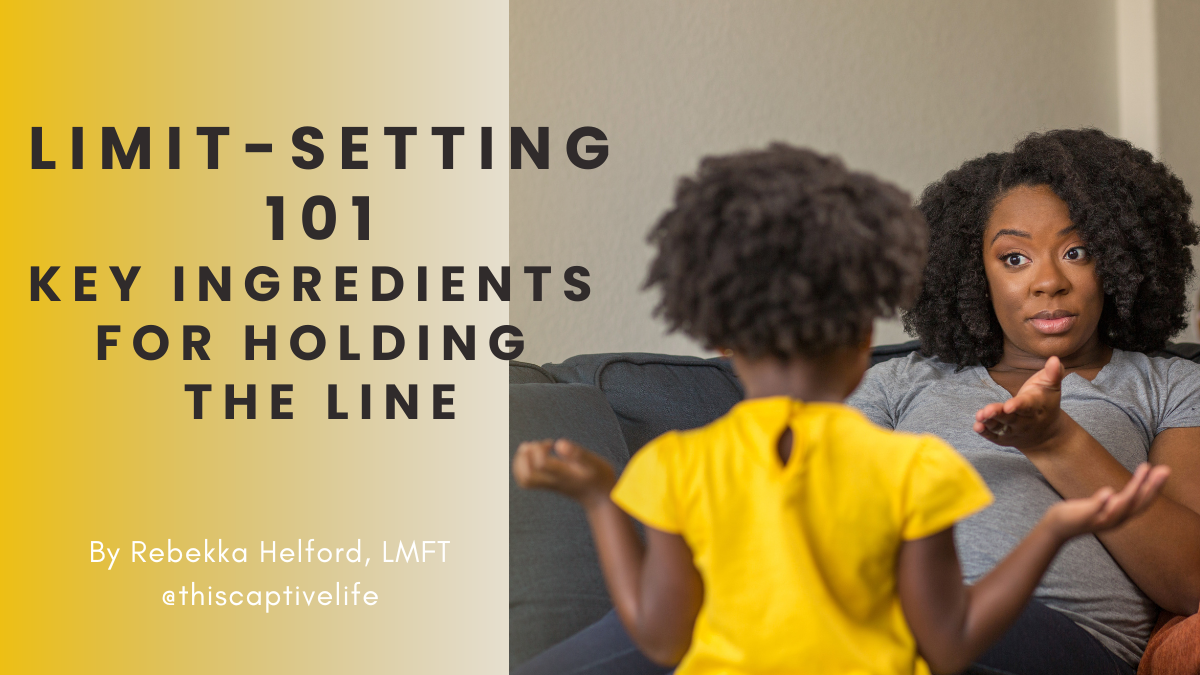Limit-setting 101: Key ingredients for holding the line
So far we've talked about why and when to set a limit. We've also discussed the importance of holding both the limit and the other's feelings. Now, it's time to talk about how to set a limit. Here are some of my favorite ideas on setting limits respectfully and also firmly.
I believe that whenever we set a limit, we must do so with the following three principles in mind (and in heart, while we're at it).
Consistency
When a limit has been established, for whatever reason, it's important to hold it consistently. That doesn't mean limits and rules will not change over time - of course they will, and there are always exceptions! For example, in your family you may have a value-based limit of not eating in front of the TV...except for movie and pizza night! Additionally, rules will change necessarily as your child ages; some limits that are appropriate for a toddler are not appropriate for school age children, and many limits for both toddlers and school age children are inappropriate for teenagers. As long as we are consistent within ourselves and among our caregiving team, for as long as the rule is relevant, we are upholding this principle.
Transparency
Transparency is the alternative to "because I said so" parenting. If we are setting, changing, or making an exception to a limit, it's important (and supportive of our authority and leadership) to be transparent about this decision and why it's being made. As I mentioned in limit-setting 101, when to set a limit, parents have a variety of totally legitimate reasons for setting a limit (including health/safety, willingness, convenience, and culture/values). When we set a limit and are clear about the reasons for doing so (or for making an exception or change), it reduces our children's anxiety and helps them understand what is going on. They don't have to like it, however! And that's where the final principle comes in.
Empathy
(See more about holding feelings here). Whenever we set a limit (or communicate in any way, really), it's important to acknowledge the other person's feelings foremost and often. TIME magazine featured a great article on this, noting that skillful parents adopt some of the same principles as seasoned hostage negotiators. Dr. Dan Siegel calls this principle "connect and redirect," and Dr. Harvey Karp calls it the "fast-food rule" (at fast food restaurants, they repeat your order back to you before giving you any other information). The goal of all of these ideas is essentially the same:
When someone is having big feelings, show that you understand and empathize with those feelings before acting on your own agenda.
This means that when we are setting a limit, we may potentially need to show empathy not once, but twice:
First, before we set the limit. We must connect with what the other is wanting, needing, and feeling. Then,
After we set the limit, when the other is having feelings about the limit that has just been set.
Some helpful phrases for acknowledging big feelings around a limit being set include:
I hear you.
I know.
I got you.
I know you don't like it.
I wish it could be another way.
Two more elements
While more procedural than the aforementioned guiding principles, I find that two additional elements are incredibly helpful when setting a limit.
Offering an acceptable alternative option
It's fine and good to tell someone they can't do something, but it's really hard to not do something when you don't have something else to do. Case in point: right now, I want you to NOT think about pink elephants. Three guesses what's on your mind right now, and the first two don't count. In order to achieve cooperation and compliance with our limits, it's helpful to tell the other person which behaviors are acceptable. Bonus points if those behaviors fulfill the same underlying goal or desire as the undesirable, forbidden behavior. For example, "You may not throw hard toys. If you are feeling like throwing, you may throw these balls or bean bags."
Checking for understanding
"The biggest problem in communication is the illusion that it has taken place." Case in point, this quote has both erroneously and ironically been attributed to, among others, George Bernard Shaw. That's why when you have communicated your limit with empathy, transparency, and consistency, the final critical step is to make sure the other person understands. You can do this by asking, "Do you understand?" or just, "Understand?"
There's one word I definitely recommend you do NOT use when checking for understanding, and that word is "Okay?" The reason for this is because saying "Okay" somewhat implies that you are asking if the limit is alright with them or if they agree with it. The truth is, these matters are irrelevant (except for when it comes to empathizing with their lack of agreement or alrightness with the limit). You don't need their approval to set a limit, you simply need their understanding.
Putting it all together
A picture (or in this case, an example) is worth 1,000 words.
Yesterday, while at a friend's house, my daughter spied an interesting treasure: a small blue marble. As we were leaving, I stooped down to fasten her shoes and saw the marble in her mouth, her lips parted in a gentle smile. I immediately scooped the marble out, put on the most serious face and voice I could muster, got down on her level, and looked her in the eye. Here is how I set a very important health/safety-oriented limit at that moment:
I know you were curious about that marble ← Empathy
And you may not put marbles in your mouth. ← Limit
Marbles are for your hands and eyes only. ← Acceptable alternative option
You can choke on marbles, and get very sick. ← Transparency
Marbles are not for your mouth. ← Consistency
I know you might not like it. ← Empathy
It's my job to keep you safe. ← Transparency
Marbles are not for your mouth. Do you understand? ← Checking for understanding
Later that night, after we'd returned home, I continued reinforcing the limit with consistency and checking for understanding.
Marbles are not for your mouth, right?
Yes. Marbles in the hand.
That's right, you may hold marbles in your hand, but not in your mouth.
I did this a few times periodically as we were playing. Eventually she began to repeat the limit herself.
Marbles not in mouth.
Yes, that's right. Marbles don't go in the mouth.
Make you choke.
Yes, I don't want you to choke on a marble, so they need to stay out of your mouth.
Marbles just in the hand.
We were just repeating the important information - life-saving information, really - over and over until she got it. No shame, no punishment, just reinforcing the limit with consistency.
Some of you out there might have gasped and panicked the moment I said my daughter placed an object of approximately toddler esophagus-diameter in her mouth unbeknownst to me. And true, I shudder to think what would have happened if I hadn't noticed when I did.
But to be 100% truthful with you, while I was certainly angry and scared that my daughter had made such an irresponsible (and yet entirely age-appropriate) choice, my limit-setting instincts took over and guided me through what might otherwise been a much scarier moment for everyone involved.
Imagine the lasting learning she would have gained as a result of me grabbing her body, yelling, or freaking out about her potentially life-threatening situation. Probably something along the lines of mommy being scary and her being bad. These pieces of learning, in addition to being largely inaccurate, also completely fail to achieve both of our overarching goals: for my daughter to stay alive and healthy for as long as possible.
And now she knows. Marbles not in mouth. Make you choke. Marbles just in the hand.
Understand?
Further reading on this topic:
Rebekka Helford is a licensed marriage and family therapist in private practice in Los Angeles, California. With over a decade of experience working with parents and young children, Rebekka specializes in short-term intensive parenting consultation, using a variety of tools including home, office, and school visits to help families navigate developmental hiccups and get back on track. Virtual visits now available!
Click here to schedule an appointment or contact Rebekka with a question – who knows, she might even answer it in her next post!


